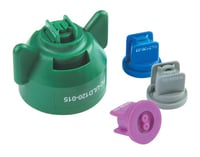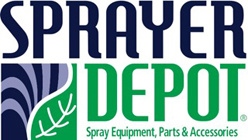 Spray tips are important, but these small components happen to be an often-overlooked part of a sprayer. With so many options on the market it’s no wonder that you might feel overwhelmed with choices. However, the benefits of finding the right tip for your application will pay in spades in the long run. Determining which spray nozzle is best for your needs depends on a variety of factors, including the type of spray application and your sprayer equipment.
Spray tips are important, but these small components happen to be an often-overlooked part of a sprayer. With so many options on the market it’s no wonder that you might feel overwhelmed with choices. However, the benefits of finding the right tip for your application will pay in spades in the long run. Determining which spray nozzle is best for your needs depends on a variety of factors, including the type of spray application and your sprayer equipment.
An appropriate spray tip can do the following:
- Reduces off target spray
- Provides more control to improve coverage
- Means you save money
- Best for the environment
- Means you complete your spray job faster
So there’s a reason why there are so many different types of spray tips in tons of sizes, capacities and materials. To get started, you should identify your needs. This first step will guide you to a narrower field of nozzle options. For instance, are you trying to reduce spray drift? Do you need a wide pressure range? What would you change about the nozzle you’ve used most recently? Do you want better coverage? Once you’ve identified your needs, then follow these three keys to selecting the right spray tip.
1. Determine Flow Rate (gpm): You’ll need to identify the application volume (gpa), travel speed (mph) and nozzle spacing in inches (w) to find the right flow rate. Your calculation may look something like this:
Flow Rate (gpm) = Volume x Speed x Nozzle Spacing
5,940
Check out the Hypro SprayIT Calculator – it’s a helpful reference guide, or TeeJet’s nozzle selection guide.
2. Select the Right Nozzle: With that information on hand you’ll have a better idea of the type of nozzle needed and can follow the manufacturer’s chart to identify the model that will work best for your needs.
Keep in mind that nozzles come in different materials. Brass resists corrosion from corrosive chemicals, plastic will not corrode and resist abrasion, stainless steel offer good corrosion resistance and are best suited for high pressures, aluminum are easily corroded by some fertilizers, and ceramic are highly resistant to abrasion and corrosion.
3. Calibrate and Adjust: After you’ve installed the new spray tip, calibrate your sprayer. This determines the amount of spray volume applied per acre. Also keep in mind that when you’re on a job, the spray pressure output of you sprayer may differ from the charts. You can adjust for this by determining the amount of pressure at the nozzle and then subtracting or adding pressure from your main gauge to compensate and ensure that you’re getting the desired output needed.
Have other suggestions to selecting the right spray tip for your needs? Maybe you’re a fan of simply calling our Customer Service Technicians to determine the right product or perhaps you have a specific brand you prefer. Either way, we’d love to hear what work best for you. Leave a comment below.


.png?width=280&name=SameDayShippingGuarantee-New%20(1).png)



